IPTV vs. OTT: Internet TV Delivery Systems Explained
The video streaming industry is full of acronyms and terms that can be confusing for the uninitiated. Two of those terms which deal with internet TV delivery are IPTV and OTT.
While both terms refer to methods of delivering content over the internet to end-users, there are differences in the mechanism or platform each uses to deliver that content.
In this article, we’ll go over the differences between IPTV and OTT, the pros and cons of each system, and help you determine which method is right for your needs.
Table of Contents
- IPTV vs. OTT: Internet TV Protocols Explained
- What Are the Major Differences Between IPTV and OTT?
- IPTV vs. OTT: Which is Right for Your Needs?
- OTT Trends for 2024 and Beyond
- The 10 Best OTT Streaming Platforms in 2024
- Conclusion
IPTV vs. OTT: Internet TV Protocols Explained
Online content streaming has become a massive part of overall internet traffic over the last decade.
In 2016, video content made up 51% of all uploads and downloads; in 2023, that share of online streaming traffic is up to nearly 65% globally. That’s a lot of content that’s moving back and forth between service providers and end-users.
Two of the ways that content is delivered online are IPTV and OTT. Both these terms are methods for delivering video content from a service provider or creator to a viewer using IP protocol, so they are similar in that manner.
However, they offer different services, are built differently, and deliver content a little differently.
Let’s investigate each method a bit further, and explore some pros and cons of choosing either IPTV or OTT.
What is IPTV?


IPTV stands for “internet-based protocol television.” It’s a digital television system that sends live and on-demand video through the web but in a controlled manner.
When TV and video content is sent using IPTV, it’s delivered over a privately managed network. This system could be a LAN (local area network), a WAN (wide area network), or an ISP (internet service provider) network.
With IPTV, bandwidth is reserved specifically for delivering video, so the quality of the video’s images and sounds is usually exceptional and without interruptions. IPTV also offers enhanced network security.
How Does IPTV Work?
Videos streamed with IPTV are stored on servers that distribute a copy of the videos any time a viewer presses play on a TV channel or on-demand content. These stored videos are sent using the multicast method, meaning the data is transmitted to a group of recipients simultaneously instead of sending individual copies to each user.
The nodes in a multicast network replicate the video content to reach multiple IP addresses, meaning that IPTV utilizes the network infrastructure and bandwidth efficiently.
Pros and Cons of IPTV
Streaming content with IPTV comes with its own set of positive and negative points:
Pros of using IPTV:
- Higher video quality: Due to the dedicated bandwidth assigned to IPTV streaming, videos tend to have a higher quality of picture and sound than with other streaming methods.
- Fewer interruptions: There are fewer instances of a video feed buffering or being interrupted with IPTV because of the private network connection.
- Hard-to-find releases: Many IPTV networks are run directly by internet service providers, and these providers offer premium content that’s only available on their streaming service.
- Enhanced security: Because IPTV is sent over a WAN, LAN, or ISP network, the security of your connection is often higher.
Cons of using IPTV:
- More expensive: Monthly fees for many IPTV services are on par with traditional satellite or cable stations, putting some users off.
- Peak slowdown: When popular content is in high demand and many people are watching a broadcast at the same time, the service can be slower.
- Locks viewers in: Viewers are locked into access to the content that the IPTV provider selects, limiting their access to other broadcasts.
- Service installation and hardware requirements: IPTV usually requires the installation of service (an internet connection from a specific ISP, for example) and either middleware or hardware from the ISP (a specific modem) in order to connect to the service.
Examples of IPTV Streaming Platforms
Some examples of well-known IPTV streaming platforms include Verizon Fios TV, DIRECTV STREAM, Movistar+, and Orange TV.
What is OTT?
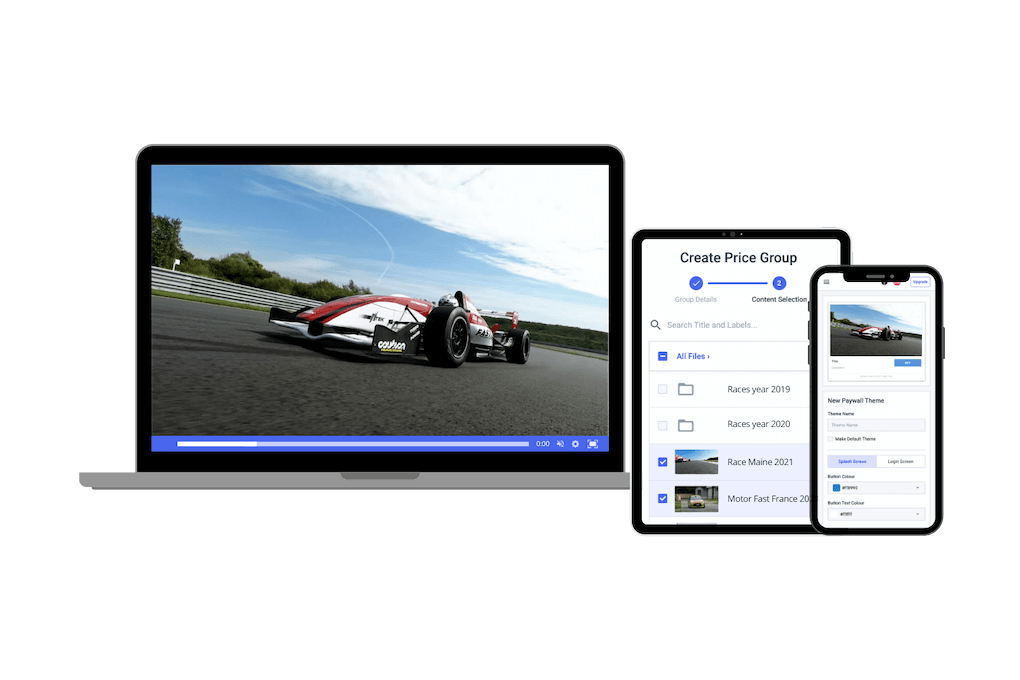

OTT stands for over-the-top streaming, meaning that video and TV programming can be streamed to any device that utilizes the internet. Content is accessible on any phone, smart TV, laptop, tablet, or video console end users have that receives an internet connection.
There are no dedicated networks for the sending of OTT content, so anyone can access video anywhere in the world.
How Does OTT Work?
OTT providers are simply streaming content providers. There are no specific distribution circuits such as those used by IPTV providers, and content is provided only upon request via unicast.
Unicase is a one-to-one transmission method that streams one piece of content to a single viewer.
ISPs still serve a role in OTT streaming technology, but only so far as they offer the infrastructure OTT hosting solutions use to stream content to end-user devices. They do not control anything about the video delivery, viewing, or content copyrights.
Pros and Cons of OTT
There are a variety of positives and negatives that come with streaming content using an OTT:
Pros of using OTT:
- Less expensive: OTTs don’t have to pay for the overall infrastructure and equipment needed to stream their content, so OTT services tend to be less expensive for users.
- More accessible: Users only need an internet-connected device to stream content via an OTT service, allowing them greater access to content anywhere in the world.
- Greater selection: Viewers are less limited by the content offered by the ISP on their proprietary service, so they have more choices in what to watch.
Cons of using OTT:
- Performance can be hampered: The quality of the content streamed to an end-user depends greatly on their internet connection speed, available bandwidth, and the connectivity speed supported by the user’s device. This can mean users experience lag, slow loading, and poor video or audio quality.
Examples of OTT Streaming Platforms
Some commonly known OTTs include YouTube, Netflix, Hulu, Amazon Prime Video, Disney+, and HBO Max.
What Are the Major Differences Between IPTV and OTT?


There are a few key differences between IPTV and OTT. Here are some of them:
- Network type: OTT content is largely delivered from content providers or content aggregators and sent directly to the viewer using an open network. IPTV, on the other hand, is a closed and proprietary network that only can be accessed via a specific ISP.
- Network relationship: OTT doesn’t require any carrier negotiations or extra infrastructure investment. IPTV services are delivered on optimized, custom high bandwidth networks that require content providers to seek agreements with the ISP.
- Content delivery: OTT uses any open internet networks available to specific users. IPTV requires a dedicated, managed network only available to users who pay the specific ISP.
- Quality of services: OTT doesn’t offer any sort of quality guarantees, with the content being delivered differently to each user based on their individual internet speeds and device capabilities. IPTV offers a reliable network with ISP control over the quality of services.
- Type of content: IPTV services usually provide an Electronic Program Guide (EPG), an on-screen listing of all scheduled programming. This guide may include listings for live television, time-shifted television that allows you to replay a show, and video on demand. OTT, however, typically offers a video on demand catalog that allows viewers to pick and choose their programming. Some OTT providers do now offer live streaming TV programs that are listed within the individual streaming service.
- Components needed: For IPTV, users need an internet connection, a router, and a set-top box or IP-based connected TV. OTT only requires an internet-compatible device that’s connected to data or WiFi.
All of these factors must be taken into account when deciding whether to utilize IPTV or OTT to distribute your content.
IPTV vs. OTT: Which is Right for Your Needs?
Now that you know the basic similarities and differences between IPTV and OTT, as well as some of the positives and negatives of each method, you can work to decide which is better for your specific streaming needs.
How IPTV Works for Streaming
IPTV streams video content over a secured network that’s controlled by a specific internet service provider. Because the ISP dedicates a specific amount of bandwidth to this streaming service, content that’s streamed via IPTV often has a higher picture and sound quality than other methods, and users experience less lag.
However, because IPTV requires a partnership with a specific ISP, it isn’t often an option for many content creators.
While you could work out a contract with the ISP for the distribution of your content, you would be required to agree to all their terms, including the monetization models you use for your content. This agreement isn’t one that many creators want to enter into, and many don’t utilize IPTV as their main source of content distribution.
How OTT Works for Streaming
OTT streams content over the internet, utilizing any open internet network available to the users streaming from the platform. The quality of the video, as well as how quickly it loads, is at the mercy of the quality of an individual user’s connection and their device capabilities.
Streaming via OTT doesn’t always require a specific contract. Much of the video that’s available on YouTube, various websites, and social media, is streamed via OTT.
Depending on the platform you choose to use for your OTT content, you may either have full freedom to control how your content is monetized and distributed, or you may be required to adhere to the platform’s choices on these features.
OTT Trends for 2024 and Beyond
The OTT industry is constantly evolving with advancements in technology and personalized streaming experiences. We analyzed key players in the streaming solutions market and gathered the latest OTT trends for streaming video in 2024 and beyond.
- A OTT expands into households, 24.6 million U.S. households have cut their TV cord. So, it is no surprise to expect that this number will rise to 46.6 million U.S. households by the end of 2024.
- Streaming industry predictions show that the OTT market size will reach a fantastic $1,039.03 billion by 2027. This is a fantastic CAGR of 29.4% from 2020 and 2027.
- 5G next-generation cellular network technology will provide much faster and more reliable internet speeds. In tests, 5G is roughly 100 times faster than the best available 4G LTE networks.
- There are 41.8% of internet users who watched content via AVOD services in 2022. This number is expected to rise to 55.8% in 2026 due to new entrants offering hybrid streaming models.
- It is predicted that the global music streaming industry will grow by a compound annual growth rate of 14.4% from 2023 to 2030.
The 10 Best OTT Streaming Platforms in 2024
There are a variety of platforms businesses and content creators can use to store, distribute and monetize streaming content. Here are 10 popular OTT platforms:
1. Dacast
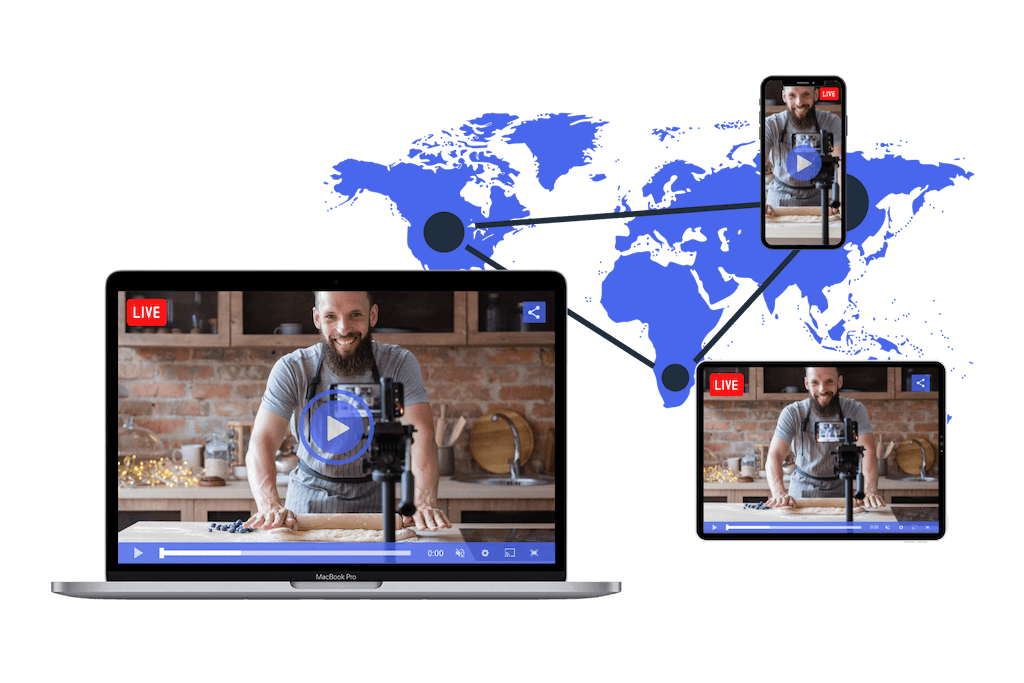

Dacast provides enterprise-grade video on demand and live streaming software for content creators and businesses. Its cloud-based video platform makes it easy for users of all experience levels to upload, organize, share and monetize video content.
Key Features
- HTML5 video player with supported universal playback
- Video API and Player API offer advanced integrations
- SVOD, TVOD, and AVOD monetization tools
- Real-time video analytics
- Advanced security capabilities, including encryption and password protection
- M3U8 media links allow streaming to mobile and smart TV apps such as Roku, Apple TV, etc.
- Secure global content delivery
- Multi-bitrate streaming
Pricing
Dacast offers pre-packaged plans beginning at $39/month, as well as custom pricing for special events or large enterprises. Packages include:
- Starter: $39/month billed annually (includes 2.4 TB bandwidth and 500 GB storage)
- Event: $63/month billed annually (includes 6 TB bandwidth and 250 GB storage)
- Scale: $165/month billed annually (includes 24 TB bandwidth and 2 TB storage)
- Custom: contact sales for custom pricing plansCustom: Contact us for custom pricing information.
2. IBM Video Cloud
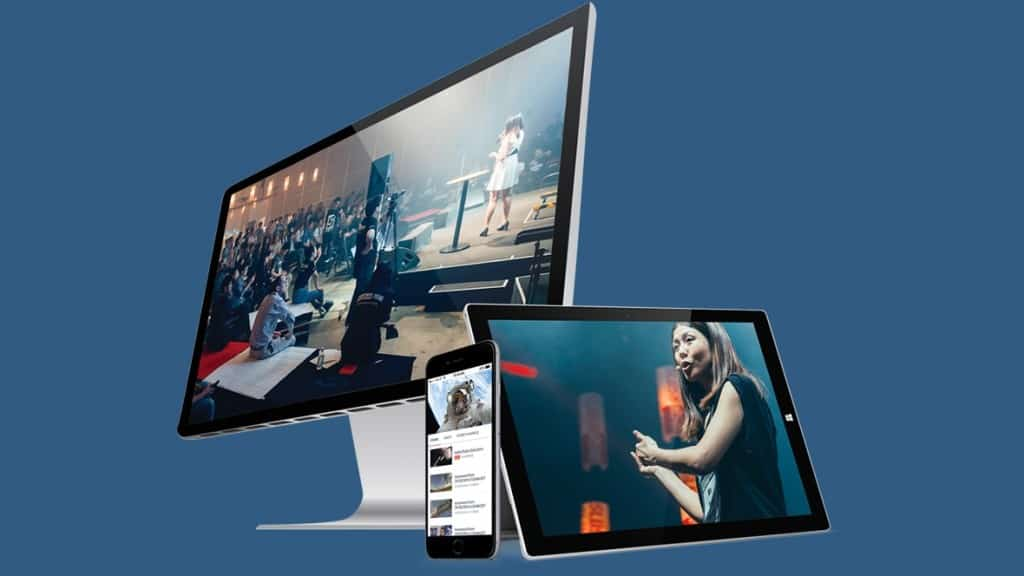

IBM Video Cloud is a reliable on-demand video option that also offers live streaming. This platform is expensive and is geared more toward enterprise broadcasters.
Key Features
- Cloud streaming for live events and VOD
- Secure video sharing
- Advanced video analytics
- Live polling tools
- Live video recording and auto-archiving
Pricing
The pricing plans for the IBM Watson Media include:
- Silver – $137/month
- Gold – $688/month
- Platinum – $1,380/month
- Custom – Please contact IBM Video Streaming for custom plan pricing.
IBM Video Streaming also offers an SaaS streaming service with AI-driven deep search for security-rich video communications. Here are the IBM Enterprise Video Streaming pricing plans:
- Enterprise Silver: $799/month
- Enterprise Gold: $1,999/month
- Enterprise Platinum: $4,999/month
- Custom: Contact the sales team
30-day free trials are available for test-driving both the IBM Video Streaming and the IBM Enterprise Video Streaming services.
3. Kaltura


Based in Israel, Kaltura offers VOD software as a service to help large institutions deliver video content to their users. This company specializes in video management and hosting services for employers and universities offering educational content.
Key Features
- Cloud-based VOD hosting
- Advanced security features, including several authentications and encryption options
- Cloud TV service
- Multi-bitrate and adaptive video streaming
- Content delivery via combined CDN
Pricing
Prices are based on the solutions you’re looking for. These include but are not limited to:
- Limited trial: $1 for two webinars
- Business: $150/month billed annually
- Enterprise: Custom pricing
- Free trial: 14 days
- Standard: $19/month up to 10 participants per session and up to 10 hrs of cloud recording
- Pro: $45/month up to 100 participants per session and up to 25 hrs of cloud recording
- Enterprise: Custom pricing for up to 10+ classrooms
- Annual discounts – Discounted pricing packages are available for any scale and use-case, enterprise SLA, and developer support. For more information, please contact sales
- Free trial account – $100 worth of credits for 30 days for testing
- Pay as you go – You pay only for what you use at these credit levels:
- Base plan: $20 one-time annual fee + monthly usage fees
Other services include virtual events, video portal town halls, video messaging, meetings and more.
4. Muvi
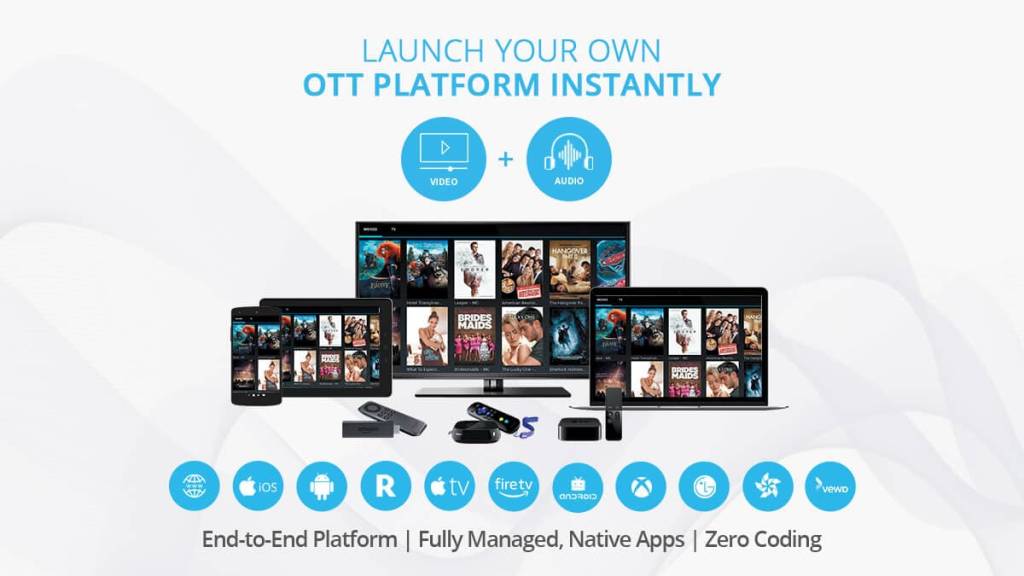

Muvi is a software as a service (SaaS) provider featuring OTT streaming. Geared toward broadcasters, users can build, manage and deploy apps and websites featuring video content.
Key Features
- VOD and video management capabilities
- Built-in CDN
- Live streaming to a variety of devices
- Support for content monetization
Pricing
Muvi offers a variety of plans and add-on options. Its standard solution starts at $399/month, but they do offer free trials so you can test their platform. Packages include:
- Standard plan: $399/month (+ $299/month per app + infra fees), allows 2,000 concurrent viewers, 1 TB each of bandwidth and storage, and 200 GB encoding.
- Professional plan: at $1,499 per month (+ $499/month per app + infra fees), includes 10,000 concurrent viewers, 2 TB each of bandwidth and storage, and 500 GB encoding.
- Enterprise plan: $3,900 per month (+ $499/month per app + infra fees), allows 50,000 concurrent viewers, 5 TB each of bandwidth and storage, and 1 TB encoding. Also adds a dedicated server.
- Ultimate plan: Custom pricing, includes unlimited concurrent viewers, doubles the bandwidth, storage, and encoding of the enterprise plan. Also adds your own CDN and auto scaling to your dedicated server.
If you have an advanced broadcasting team, the technical features Muvi offers as an OTT service provider may be just what you need.
5. Wistia


Wistia is a VOD software solution providing “TV-quality” streaming. This includes a white-label video player that is fully customizable to meet your individual needs.
Key Features
- Custom branding of the video player
- Interactive cloud tools for video content
- CRM integration
- In-depth analytics
Pricing
Wistia has four pricing plan tiers. These plans are billed annually and include:
- Free: No cost to use; 10 videos max; 1 user
- Plus: $19/month; 20 videos included; 3 users
- Pro: $79/month; 50 videos included; 5 users
- Advanced: $319/month; 250 free videos; 20 users
Wistia also has enterprise solutions for businesses and educational providers looking for a professional grade OTT service provider.
6. Wowza
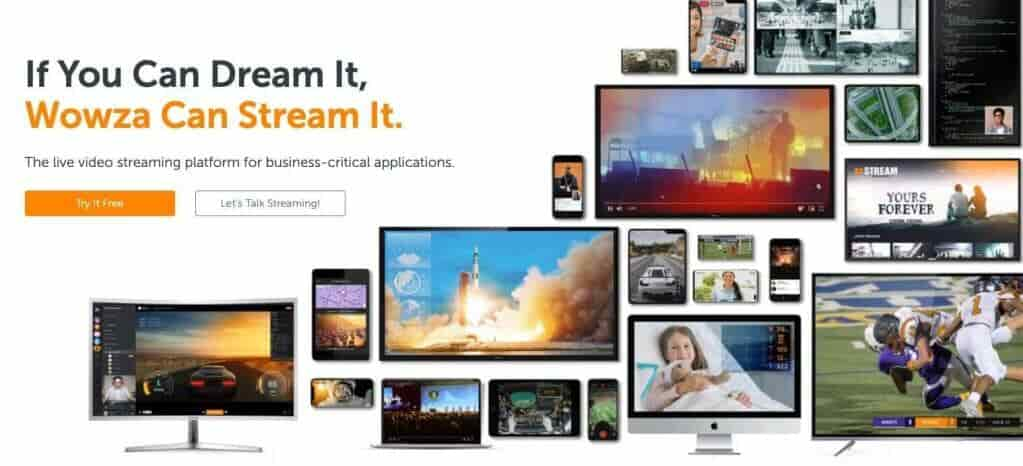

Caption: Wowza enables broadcasters to reliably deliver both live and on-demand content to users.
Wowza is an online video platform that supports both VOD and live streaming. Additional services are available, including a self-hosted media server for live events.
Key Features
- Self-managed streaming infrastructure
- Managed live streaming service
- Adaptive video playback
- Encrypted streaming offers secure video delivery
Pricing
Wowza recently overhauled its pricing plans and added several options. These are split into 2 main tiers: Wowza Video and Wowza Streaming Engine
The Wowza Video Cloud Streaming offers four distinct pricing plans and services.
- One Month of Streaming: $149 one-time purchase; includes 15 hours of live streaming and 500 viewing hours
- Pay as you go: $0/month; $2.50/hour of streaming, all usage billed separately
- Enterprise: Annual plans built for your needs; contact sales for custom pricing
The Wowza Streaming Engine has its own pricing plan packages. These professional-grade streaming plans are billed annually and include:
- One Month of Streaming: $295/month one-time purchase
- Basic monthly: $195 per month
- Enterprise: Please contact Wowza directly for access to their custom-tailored high-volume enterprise solutions
Check out Wowza’s pricing page for alternative plans and packages.
If you need a budget-friendly video hosting platform with streaming security, try Wowza.
7. Brightcove
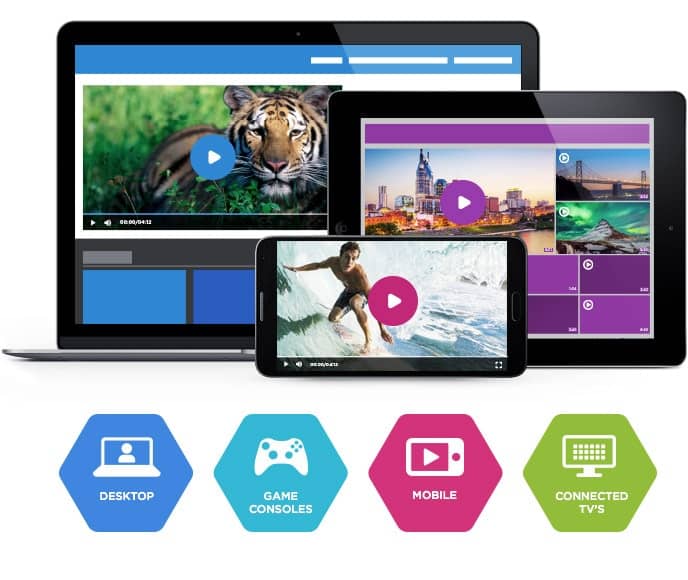

Brightcove’s video hosting is designed for both video monetization and marketing. They were founded in 2004 and allow for easy integration of marketing and advertising campaigns in both its video cloud and video player capabilities.
Key Features
- Multiple app integrations for extra customization
- Live event and 24/7 streaming capabilities
- Customizable monetization and advertising settings
- Powerful editing tools
Pricing
Since Brightcove mainly targets enterprise-level clients, they offer several custom-priced streaming plans at high price points.
Custom pricing tiers for Starter, Professional, and Enterprise.
Interested broadcasters can contact their sales department to receive a quote or sign up for a 30-day free trial. When you need something simple with complex tools, Brightcove is a good choice.
8. JW Player
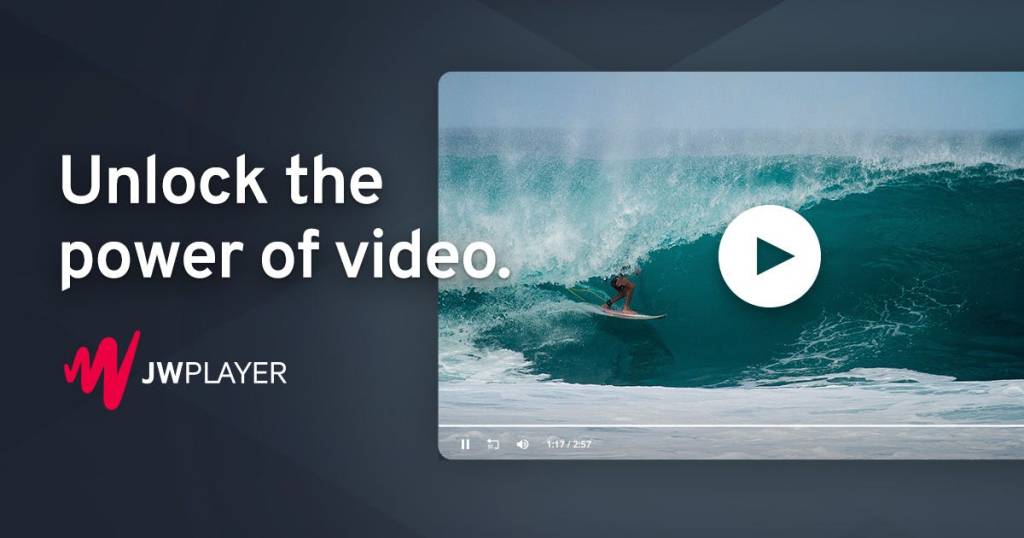

JW Player provides VOD hosting and live streaming with limited features, so it’s suited to those on a tight budget. It makes up for its limited slate of features with exceptional customer service.
Key Features
- Tokenized access and DRM support
- Video analytics
- Ad optimization
- Video distribution management
Pricing
JW Player essentially offers 4 pricing tiers:
- Stream: Includes video delivery, instant live, broadcast live, and asset management
- Play: Includes cloud hosting, a HTML5 player, OTT apps, and mobile SDKs
- Engage: Offers realtime analytics, article matching, custom reports, and recommendations
- Monetize: Has ad insertion features, outstream ads, studio DRM, and player bidding
With JW Player, you will need to contact sales to discuss your needs and get custom pricing or start with a free trial.
Publishers and broadcasters should contact JW Player directly for pricing and features.
9. Livestream


Livestream is suited for professionals looking for an all-in-one platform for business use. Owned by Vimeo, the Vimeo OTT platform allows for the streaming, managing, and monitoring of video content with marketing, video management analytics, and live streaming capabilities.
Key Features
- Simulcasting and multistreaming support
- Viewer engagement tools (polling and chat options)
- Powerful security tools
- Custom video gallery pages
- In-house content delivery
- White-label video player
Pricing
Vimeo Livestream offers three main pricing plans, including:
1) Vimeo Premium:
- Premium pricing: $65/month
- Their Premium plan includes both live streaming and VOD support. This plan is the best option for professional broadcasting on this platform.
2) Vimeo Enterprise:
- Enterprise Pricing: Please contact Vimeo for custom pricing information
- The Enterprise plan includes white-label service, monetization, and video API access. It also includes branding control and added security features.
3) Vimeo OTT:
- Vimeo’s OTT solution is priced separately from the regular Vimeo packages. There are two plans: Starter and Enterprise.
- Starter Pricing: $1/subscriber per month
- Enterprise Pricing: Please contact Vimeo for custom pricing information
10. SproutVideo


SproutVideo provides live and VOD hosting with a range of plans to suit all budgets and needs.
Key Features
- All plans include live chat support
- API access
- Customizable privacy and security features
- Detailed analytics reporting
Pricing
SproutVideo offers four pricing plans for different budgets, including:
- Seed: $10/month
- Sprout: $35/month
- Tree: $75/month
- Forest: $295/month
Check out SproutVideo’s pricing plans for more information.
FAQs:
1. Which is better, OTT or IPTV?
Whether OTT or IPTV is better depends on the user’s needs. IPTV offers a more stable, high-quality viewing experience since it runs on managed networks but requires specific hardware and a subscription with a telecom provider. OTT, on the other hand, is more flexible, allowing users to access content on various devices over the public internet, often with more diverse content options like on-demand streaming services. IPTV may be better for users who want a traditional TV experience with guaranteed quality, while OTT is ideal for those seeking convenience and variety. Ultimately, OTT is more accessible and adaptable, but IPTV provides a more controlled and reliable service.
2. What is the difference between IPTV and connected TV?
IPTV delivers television content over a dedicated private network, typically requiring a set-top box and offered by telecom providers. It focuses on live TV and video on demand, similar to traditional cable but delivered via IP networks. Connected TV (CTV) refers to any internet-connected TV or device (like smart TVs or streaming sticks) that allows access to various streaming platforms. CTV relies on the public internet and supports a broader range of content, from on-demand streaming to ad-supported services, without needing specific provider hardware. IPTV uses a subscription model with managed networks, while CTV is more flexible and device-agnostic.
3. What is the is primary difference between IPTV and OTT in 5 sentences?
The primary difference between IPTV and OTT lies in their delivery methods. IPTV uses a private, managed network provided by telecom companies, requiring dedicated hardware like set-top boxes. OTT (Over-the-Top) delivers content over the public internet, accessible on a wide range of devices, including smart TVs, smartphones, and computers, without specific provider hardware. IPTV typically offers live TV channels, video on demand, and is subscription-based, whereas OTT includes platforms like Netflix and YouTube, often using ad-supported or subscription models. In short, IPTV is a closed, provider-controlled system, while OTT is more open and internet-based.
4. What is the future of over-the-top OTT video?
The future of OTT video looks set for continued growth as more consumers shift from traditional TV to internet-based streaming. With advancements in technology, OTT platforms will offer increasingly personalized content, enhanced user experiences, and seamless integration across devices. The rise of ad-supported models and hybrid subscription options will further diversify monetization strategies, attracting more viewers. As competition increases, content providers will invest heavily in original programming and exclusive deals to retain subscribers. Additionally, 5G and improved internet infrastructure will boost the accessibility and quality of OTT services worldwide, making them even more dominant.
5. What is next after IPTV?
After IPTV, the future points toward more advanced, cloud-based streaming technologies and enhanced user experiences through AI-driven personalization. 5G networks will play a significant role in enabling faster, more reliable delivery of high-quality content, reducing dependency on physical set-top boxes and making streaming more mobile and flexible. Cloud-based TV services may replace traditional IPTV, offering greater scalability, improved content management, and seamless access across multiple devices. Interactive and immersive experiences, such as virtual reality (VR) and augmented reality (AR), could become more integrated into TV viewing. Ultimately, the convergence of AI, OTT cloud streaming, and advanced networks will redefine how people consume content, making it more personalized, interactive, and on-demand.
Conclusion
For most video content creators, OTT is the delivery method that makes the most sense for their needs. It allows greater control over their content, better customization of monetization, and opens them up to a wider audience.
If you want OTT software that offers a wide variety of tools and features while also being affordable, consider Dacast. With a 14-day free trial, you get access to everything Dacast has to offer without having to sign a contract, pay high start-up fees, or give us your credit card number. Try Dacast today.
For regular live streaming tips and exclusive offers, we invite you to join the Dacast LinkedIn group.

 Connect
Connect
 Events
Events Business
Business Organizations
Organizations Entertainment and Media
Entertainment and Media API
API Tools
Tools Learning Center
Learning Center Support
Support Support Articles
Support Articles